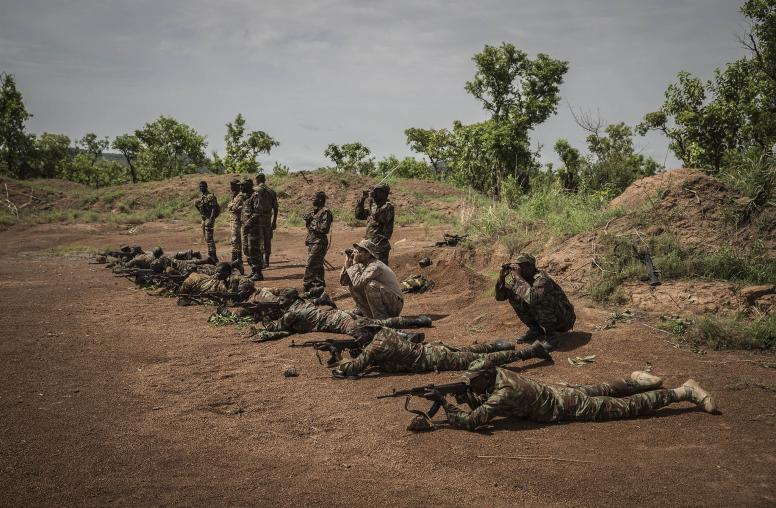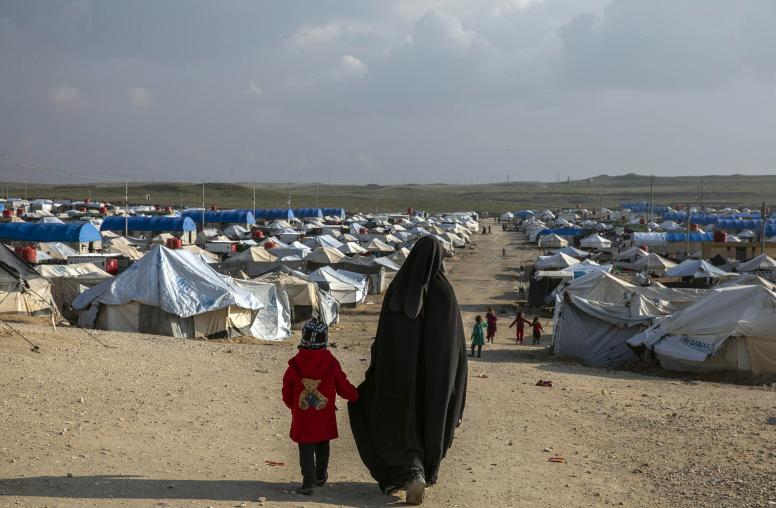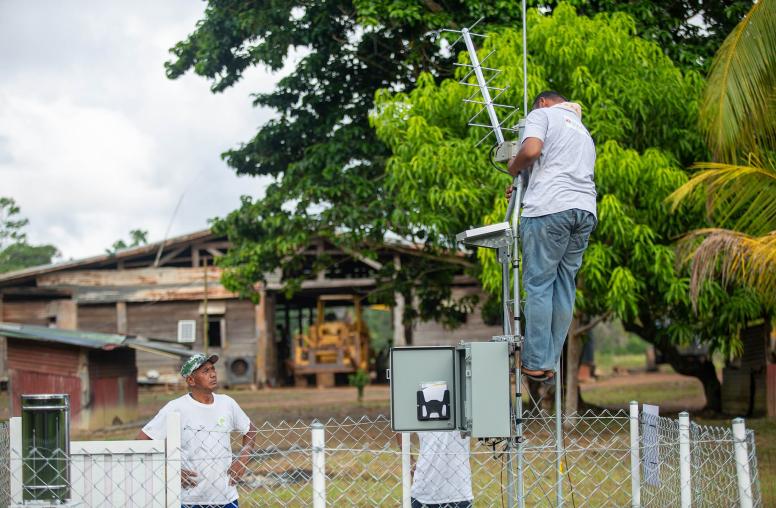To End ISIS, We Must Find Futures for Its Survivors
Security professionals and peacebuilders agree: We can defuse violent extremist networks as we have cults and gangs.
At age 15, Shamima Begum ran away from home in England and, with two girlfriends, ventured into Syria’s war to join ISIS. Within days, she was married to an ISIS fighter; she has since had three children, all of whom have died. Begum, one of 70,000 former residents of the ISIS-declared state now confined in a displacement camp in Syria’s desert, is asking a British court to overturn a government order that stripped her of her citizenship. As nations worldwide seek justice, accountability—and their own security from ISIS’ violent extremism—Begum’s story shows how a “peacebuilding” approach is needed.

The United States and dozens of other nations must decide what to do with their citizens who traveled to live or fight in ISIS’ “caliphate.” Of 50,000 who did so, nearly 20,000 remain in detention or displacement camps in the region. About 14,000 women and children from countries beyond Iraq and Syria now face malnutrition, hypothermia and continued violence in sprawling camps such as the one at al Hol, near Syria’s border with Iraq.
The United Kingdom is among a majority of nations that have sidestepped this challenge, leaving their citizens stateless and vulnerable to frequent desperation in overcrowded camps. The United States has been repatriating people who fought for ISIS, bringing criminal charges against several, but the prospects of repatriating women and children remain unclear.
As of February 2019, at least 13 American women and children who lived under ISIS remained stranded in the region, The New York Times found. Some have been repatriated, but others face an uncertain fate. Such cases are “extremely complicated,” a State Department spokesman told the Times. Residents often lack identity or citizenship documentation and evidence of their activities with ISIS is scant.
Yet, if justice and security are the concerns, then displacement camps in northeast Syria are undermining both and securing neither. The camps lack legal institutions that could serve justice to Begum and others. Refusing to repatriate people out of fear that they may escape justice only reflects a lack of faith in our own justice systems. Moreover, the camps lack mechanisms to monitor residents’ activities or to support their disengagement from violent extremism. Indeed, al Hol is not secure against ISIS. Devotees of the group have escaped to rejoin remnants of the group; others within the camp enforce the violent social norms of the caliphate, bringing up thousands of children devoted to ISIS. Data shows that repatriation helps sever people’s direct links with ISIS. Recidivism rates among people disengaged from violent extremism are exceptionally low—around 10 percent, compared to 60 percent for people who served prison time for other violent crimes.
Security Professionals Sound the Alarm
Providing pathways for people to exit groups like ISIS is vital to national security. The prevailing “‘hands off’ stance [among governments] will only create greater danger in the future,” according to a dozen prominent former U.S. national security officials, writing a year ago. “The denial of citizenship by their home nations will bolster their sense of being, in effect, citizens of the Islamic State, potentially preparing them to form the core of a future resurgence.”
That letter was signed by professionals who have served as directors of the U.S. National Counterterrorism Center, FBI officers, and officials of police departments and the National Security Council. A wide spectrum of professionals—from law enforcement, medical and social disciplines, and the peacebuilding field—agree on the need to apply a broad set of tools to this problem. These must include repatriation, prosecution, mental health care, rehabilitation and reintegration of people into their home societies.
“By prosecuting militants and their enablers, the West will reveal these people for the violent criminals they are—not the martyrs they claim to be—while . . . showing that democratic states are capable of delivering justice,” the open letter said.
In an online policy forum hosted by USIP this month, General Kenneth McKenzie, commander of the U.S. Central Command, agreed. “The enduring defeat of ISIS has got to incorporate a way forward for the displaced persons and all the people that are at risk across the theater; if not, we are actually never really going to defeat ISIS and the problem is going to come back,” he said. “We can either deal with this problem now or deal with it exponentially worse a few years down the road.”
The Peacebuilding Approach
The vast mix of people who lived with ISIS—from hardened fighters, to schoolgirls such as Shamima Begum or the Alabama high school graduate Hoda Muthana, to children born during the conflict—supports the need for rehabilitation and reintegration, using a peacebuilding approach.
To drain violent extremist groups of their adherents, one vital step is counterintuitive: letting go of our instinct to convince such people that their interpretations of religion, ideology, or values are wrong. Applying pressure by arguing against deeply held beliefs only causes them to retreat further into their ideological shelters, buttress their commitment to the cause and erect fortresses against rehabilitation efforts. Instead, we must draw upon behavioral strategies that are proven in dismantling violent gangs and cults.
The reasons why ISIS propaganda found resonance for Begum, Muthana and thousands of others—many of them children—are complex and personal. For each of us, our own response to an extremist appeal is shaped by a deep mix of personal experiences, social norms, perceptions of political and economic equity, and other factors. These include our traumas, emotional needs and even brain chemistry. When we have deep needs and a sense of alienation from the communities around us, and little faith that legitimate channels will rectify grievances, we might—as Begum and other ISIS recruits did—listen to what seem empathetic voices inviting us to join what they tell us is a righteous community. When mainstream society alienates people, fringe groups welcome them. If we feel marginalized, isolated, or victimized by power structures in our lives, we may become vulnerable to an extremist appeal.
Another complication: The reasons people engage in violent extremism do not always correspond to the reasons they choose to disengage. Peacebuilding offers a framework through which Begum and others can abandon violence as a means to pursue a goal. She can reconcile with her community in a way that provides a sense of justice and accountability while also reducing fear and anger toward her, effectively allowing her to reintegrate into society.
Giving People an Exit Ramp
A strategy to help draw people out of violent extremist groups should include elements such as these:
- Treat violent extremism as we successfully treat similar social dysfunctions: harmful drug use, domestic violence and gang violence. We regularly look to behavioral science for clinically validated methods to change such behaviors. For people drawn into violent extremism, methods such as behavioral health, harm reduction and violence prevention can improve their access to services, encourage socialization with people who reject violence and encourage help-seeking behavior. These methods build the resilience of communities against extremists’ appeals, and they have been validated through decades of public health practice.
- Recognize the impacts of trauma. Extremist organizations, like gangs and cults, are abusive to their members. Women within ISIS were routinely raped; children were forced to conduct executions. For Begum and others, trauma can impede rehabilitation. It makes people feel isolated and discourages them from forming social bonds or seeking help. People who work with former ISIS members—including health providers, police, social workers, employers and family members—should be trained in ways to avoid worsening trauma’s effects.
- Harness lessons from experience and research on why people voluntarily exit groups, including violent and ideological ones, like gangs and cults. For people trying to leave abusive networks, it is essential to build relationships with community members and institutions. This helps them build empathy and social bonds with others, promotes a sense of belonging and offers an alternative identity. If Begum or other ISIS survivors can feel a part of a community, they will tend to trade negative behaviors for ones accepted by their peers. Conversely, if ostracized by their communities they are likely to revert to the hostilities that fomented their mobilization to violence.
- Ensure behavioral healthcare and psychosocial support for returnees. People disengaging from extremist and abusive networks are likely to endure hopelessness, fear, grief, shame and a loss of control over their lives. These can amplify feelings of alienation and contribute to recidivism. Healthcare and support services to address these challenges are vital.
- Watch our language. Reducing stigma is critical to disengagement, so let’s avoid stigmatizing language. Language has the neurological power to shape perceptions. Labeling women like Begum with terms like “ISIS bride” risks creating a self-fulfilling prophecy. A description like “people disengaging from violent extremism” can avoid reinforcing the identities people are disengaging from. It helps to identify people first as people.
- Provide a sense of justice. People exiting ISIS may face prosecution that seeks justice for crimes through punishments such as prison. Whatever that outcome, the community into which people return may feel angry that punishment has been lenient or that justice otherwise has not been served. “Restorative justice,” a concept that focuses on repairing harm caused by an offense, will be crucial to achieving reconciliation. The first tool for this is a compassionate dialogue that lets an offender acknowledge the harm done, accept responsibility and restore dignity to victims. That step promotes redemption, opening space for the community to offer restored membership to the returnee.
- Acknowledge and label people’s transformation. People tend to conform to the behavioral expectations of the labels society gives them. Symbolically demarcating a returnee’s transition from violent extremist to rehabilitated member of society can be a powerful tool contributing to the disengagement process.
- Link with efforts to prevent violent extremism. People disengaging from violent extremism often must do so in the same environment in which they were initially mobilized to engage. Communities should connect their prevention and rehabilitation work, addressing the grievances and dynamics that facilitate violent extremism in the first place.
Building this kind of strategy is vital for the challenge posed in last year’s open letter by former security officials. As they noted, we can “pay a relatively small price now, or pay a huge price later.” They are correct that “breaking the cycle of violence will not be easy, but it is better than sleepwalking back into the mistakes of the past.”



